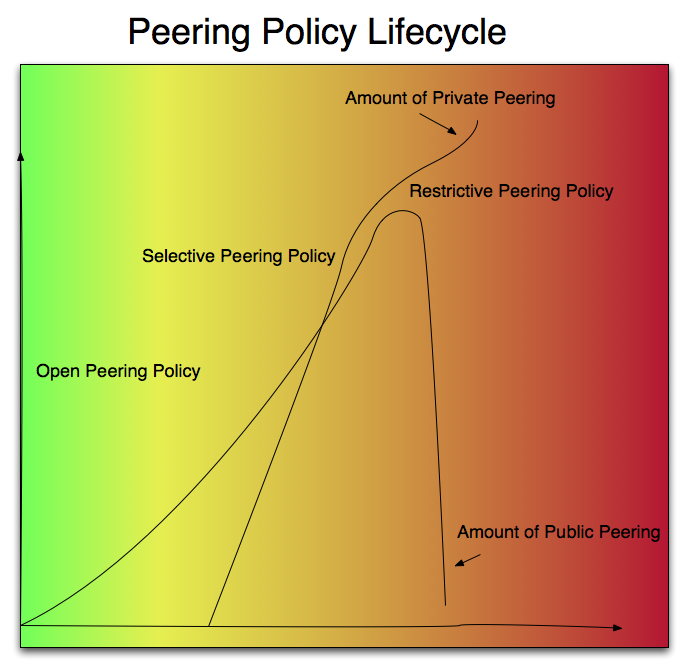This page is about the lifecycle of an ISP Peering policy; from starting up with an Open Peering Policy, to growing and becoming more selective, to becoming a Tier 1 ISPs and becoming restrictive in peering inclination.
At a NANOG Peering BOF, Vijay Gill described various stages in the lifecycle of a peering network, characterized by a change in motivations.

During this lifecycle, from a small network just beginning its peering, to a huge network that sends 100% of its traffic to peering, the motivations for public vs private peering changes vastly.
In stage 1, the peering network usually has no choice but to peer publicly. The choice of where and how to peer is largely dictated by the other party, and the peering networks usually chooses locations based solely on the number of other peering partners available there.
In stage 2, the peering network is usually enjoying the capacity and burstability benefits of a relatively large peering port. They usually prefer to keep peers on these large public ports, and any private peers they establish will be based on the requirements of the other party, and will be of a capacity smaller than their public peers.
In stage 3, the peering network is moving some of their largest peers to private peering, but continues to use public peering to aggregate most of the smaller peers. While they are often not looking to establish new peering with any new network who connects to a public peer, the public peer is still an excellent location to conduct trials.
In stage 4, the peering network is attempting to divorce itself from its public peering. The majority of its traffic by volume is now being sent via large private peers, and public peers are not being upgraded. As peers increase their traffic levels, they are moved onto private peering. Towards the end of stage 4, the peering network may seek to disconnect public peering ports it considers less important.
In stage 5, the peering network sees almost no value in public peering. Some may retain presences solely for political reasons, such as avoiding the confrontation of de-peering another network and instead simply limiting the growth of new peering. Other networks may disconnect themselves from public peering completely at this point.
Internet Transit Pricing Historical and Projections
Index of other white papers on peering
WIlliam B. Norton is the author of The Internet Peering Playbook: Connecting to the Core of the Internet, a highly sought after public speaker, and an international recognized expert on Internet Peering. He is currently employed as the Chief Strategy Officer and VP of Business Development for IIX, a peering solutions provider. He also maintains his position as Executive Director for DrPeering.net, a leading Internet Peering portal. With over twenty years of experience in the Internet operations arena, Mr. Norton focuses his attention on sharing his knowledge with the broader community in the form of presentations, Internet white papers, and most recently, in book form.
From 1998-2008, Mr. Norton’s title was Co-Founder and Chief Technical Liaison for Equinix, a global Internet data center and colocation provider. From startup to IPO and until 2008 when the market cap for Equinix was $3.6B, Mr. Norton spent 90% of his time working closely with the peering coordinator community. As an established thought leader, his focus was on building a critical mass of carriers, ISPs and content providers. At the same time, he documented the core values that Internet Peering provides, specifically, the Peering Break-Even Point and Estimating the Value of an Internet Exchange.
To this end, he created the white paper process, identifying interesting and important Internet Peering operations topics, and documenting what he learned from the peering community. He published and presented his research white papers in over 100 international operations and research forums. These activities helped establish the relationships necessary to attract the set of Tier 1 ISPs, Tier 2 ISPs, Cable Companies, and Content Providers necessary for a healthy Internet Exchange Point ecosystem.
Mr. Norton developed the first business plan for the North American Network Operator's Group (NANOG), the Operations forum for the North American Internet. He was chair of NANOG from May 1995 to June 1998 and was elected to the first NANOG Steering Committee post-NANOG revolution.
William B. Norton received his Computer Science degree from State University of New York Potsdam in 1986 and his MBA from the Michigan Business School in 1998.
Read his monthly newsletter: http://Ask.DrPeering.net or e-mail: wbn (at) TheCoreOfTheInter (dot) net
Click here for Industry Leadership and a reference list of public speaking engagements and here for a complete list of authored documents
The Peering White Papers are based on conversations with hundreds of Peering Coordinators and have gone through a validation process involving walking through the papers with hundreds of Peering Coordinators in public and private sessions.
While the price points cited in these papers are volatile and therefore out-of-date almost immediately, the definitions, the concepts and the logic remains valid.
If you have questions or comments, or would like a walk through any of the paper, please feel free to send email to consultants at DrPeering dot net
Please provide us with feedback on this white paper. Did you find it helpful? Were there errors or suggestions? Please tell us what you think using the form below.
Contact us by calling +1.650-614-5135 or sending e-mail to info (at) DrPeering.net